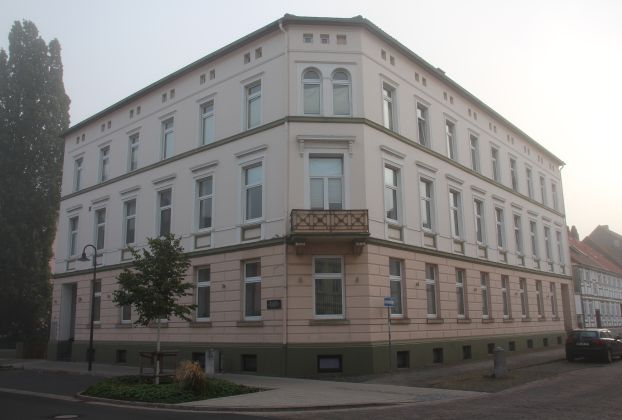When walking from the railway station to the old city centre/Palace of Bückeburg there is one short stop us royalty-watchers should make. Somewhere halfway is a house with a plaque on the wall saying (in German):
Luise von Lehzen
Educator to the Queen
Victoria of Great Britain
lived in this house
from 1842 until 1870

Johanna Clara Louise Lehzen was born on 3 October 1784 in the Kingdom of Hannover as the youngest of the nine children of the Lutheran pastor Joachim Lehzen and his wife Melusine Palm. As a young women she started working as a governess for the three daughters of the noble family Von Marenholtz. She must have done a great job as in December 1819 she was hired as a governess for the then 12-year-old Princess Feodora of Leiningen, daughter of the new Duchess of Kent from her first marriage. Louise had learnt English from an early age, as her father had lived in London for a while.
1824 she became the governess of the only child of the Duchess of Kent and the late Duke of Kent (died 1820), Princess Alexandrina Victoria, who had been born in May 1819. At the Kensington Palace, where the life of Victoria was dominated by her mother and her comptroller Sir John Conroy, Louise Lehzen provided a safe heaven for Victoria. She protected the little princess enormously, but therefore also caused friction within the household and between Victoria and her mother. As she was supported by the uncles of Victoria the household didn’t manage to have Louise Lehzen removed from her position. Louise Lehzen even received the Hanoverian title of Baroness from King George IV in 1827 after people had complained that the future queen shouldn’t be surrounded with commoners. “Dear, good Lehzen”, as she was called by Victoria, raised the little heir to the throne as a strong, informed and independent child.
Louise Lehzen was stern, and according to historian Christopher Hibbert she was “a handsome woman, despite her pointed nose and chin, clever, emotional, humourless”. She was however also caring. Under her guidance and that of her tutor the Rev George Davy Victoria gained an “enlightened education” and learned to speak French, German, Latin and English, and was taught economics, history, geography, mathematics, politics, art, music and dancing.
After the 18-year-old Victoria became Her Majesty The Queen in June 1837 Louise Lehzen turned into an unofficial private secretary and was called lady attendant. She was responsible for Victoria’s clothes and jewelry as well as for her personal expenses. She also was in the possession of the keys, which showed her important position in the household. Her appartments at the Buckingham Palace were adjacent to the ones of Victoria, while those of Victorias mother were much further away. There was even a private doorway from her room into the royal bedroom. In July 1837 Victoria wrote:
My beloved and faithful Lehzen I cannot sufficiently praise; no words can express what she has done, what she has endured for me!! I can never never recompense her sufficiently for all, all what she has borne and done for me these 13 years! that she has been with me.
Her position however was to be changed soon. In February 1840 Victoria married Prince Albert of Saxe-Coburg-Gotha, a man who didn’t like Lehzen and her huge influence on his wife. He called her “the hag” and a “crazy stupid intriguer”. The deep antipathy was mutual. When in January 1842 the eldest daughter of the couple, Princess Victoria, became seriously ill, Lehzen had been in charge of the nursery since little Victoria’s birth and had appointed Sir James Clark as a doctor, against the wishes of Prince Albert, and Clark failed to recognise the seriousness of the illness. Especially Albert was furious and dismissed Lehzen on 25 July 1842, without the knowledge of Victoria, who thought her beloved confidant was to retire due to her ill health. Finally on 30 September 1842 Louise Lehzen quietly left the palace, without saying goodbye to the Queen, so the departure would be less painfull.
Louise Lehzen returned to the Kingdom of Hanover with a pension of £800 per annum, and also was gifted a carriage. She moved to Bückeburg, not far from Hanover, where one of her sisters lived, although her sister soon died. Victoria never forgot her former governess. She kept on corresponding with her regularly and even paid her two visits when travelling to Germany, the last in Rheinhardsbrunn in 1862. She also sent her gifts, like a wheeled chair when she got older. The walls of Lehzen’s house were covered with portraits of her beloved Victoria. Louise Lehzen died in Bückeburg on 9 September 1870, aged 85. She is buried in the Jetenburger cemetery. The erection of a memorial in neo-gothic style was ordered by Queen Victoria and reminds visitors of the cemetery of Louise Lehzen until today.
